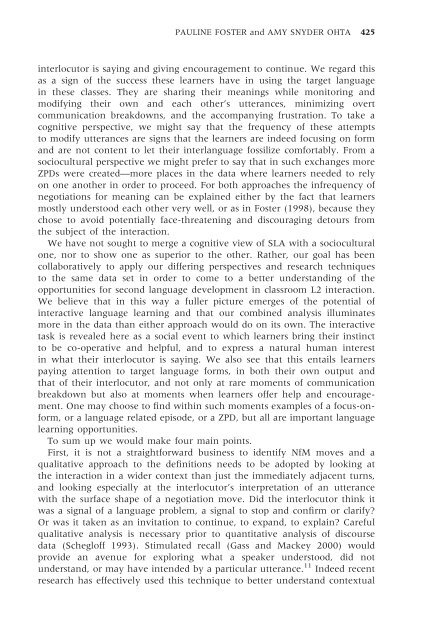Negotiation for Meaning and Peer Assistance in Second Language ...
Negotiation for Meaning and Peer Assistance in Second Language ...
Negotiation for Meaning and Peer Assistance in Second Language ...
You also want an ePaper? Increase the reach of your titles
YUMPU automatically turns print PDFs into web optimized ePapers that Google loves.
PAULINE FOSTER <strong>and</strong> AMY SNYDER OHTA 425<br />
<strong>in</strong>terlocutor is say<strong>in</strong>g <strong>and</strong> giv<strong>in</strong>g encouragement to cont<strong>in</strong>ue. We regard this<br />
as a sign of the success these learners have <strong>in</strong> us<strong>in</strong>g the target language<br />
<strong>in</strong> these classes. They are shar<strong>in</strong>g their mean<strong>in</strong>gs while monitor<strong>in</strong>g <strong>and</strong><br />
modify<strong>in</strong>g their own <strong>and</strong> each other’s utterances, m<strong>in</strong>imiz<strong>in</strong>g overt<br />
communication breakdowns, <strong>and</strong> the accompany<strong>in</strong>g frustration. To take a<br />
cognitive perspective, we might say that the frequency of these attempts<br />
to modify utterances are signs that the learners are <strong>in</strong>deed focus<strong>in</strong>g on <strong>for</strong>m<br />
<strong>and</strong> are not content to let their <strong>in</strong>terlanguage fossilize com<strong>for</strong>tably. From a<br />
sociocultural perspective we might prefer to say that <strong>in</strong> such exchanges more<br />
ZPDs were created—more places <strong>in</strong> the data where learners needed to rely<br />
on one another <strong>in</strong> order to proceed. For both approaches the <strong>in</strong>frequency of<br />
negotiations <strong>for</strong> mean<strong>in</strong>g can be expla<strong>in</strong>ed either by the fact that learners<br />
mostly understood each other very well, or as <strong>in</strong> Foster (1998), because they<br />
chose to avoid potentially face-threaten<strong>in</strong>g <strong>and</strong> discourag<strong>in</strong>g detours from<br />
the subject of the <strong>in</strong>teraction.<br />
We have not sought to merge a cognitive view of SLA with a sociocultural<br />
one, nor to show one as superior to the other. Rather, our goal has been<br />
collaboratively to apply our differ<strong>in</strong>g perspectives <strong>and</strong> research techniques<br />
to the same data set <strong>in</strong> order to come to a better underst<strong>and</strong><strong>in</strong>g of the<br />
opportunities <strong>for</strong> second language development <strong>in</strong> classroom L2 <strong>in</strong>teraction.<br />
We believe that <strong>in</strong> this way a fuller picture emerges of the potential of<br />
<strong>in</strong>teractive language learn<strong>in</strong>g <strong>and</strong> that our comb<strong>in</strong>ed analysis illum<strong>in</strong>ates<br />
more <strong>in</strong> the data than either approach would do on its own. The <strong>in</strong>teractive<br />
task is revealed here as a social event to which learners br<strong>in</strong>g their <strong>in</strong>st<strong>in</strong>ct<br />
to be co-operative <strong>and</strong> helpful, <strong>and</strong> to express a natural human <strong>in</strong>terest<br />
<strong>in</strong> what their <strong>in</strong>terlocutor is say<strong>in</strong>g. We also see that this entails learners<br />
pay<strong>in</strong>g attention to target language <strong>for</strong>ms, <strong>in</strong> both their own output <strong>and</strong><br />
that of their <strong>in</strong>terlocutor, <strong>and</strong> not only at rare moments of communication<br />
breakdown but also at moments when learners offer help <strong>and</strong> encouragement.<br />
One may choose to f<strong>in</strong>d with<strong>in</strong> such moments examples of a focus-on<strong>for</strong>m,<br />
or a language related episode, or a ZPD, but all are important language<br />
learn<strong>in</strong>g opportunities.<br />
To sum up we would make four ma<strong>in</strong> po<strong>in</strong>ts.<br />
First, it is not a straight<strong>for</strong>ward bus<strong>in</strong>ess to identify NfM moves <strong>and</strong> a<br />
qualitative approach to the def<strong>in</strong>itions needs to be adopted by look<strong>in</strong>g at<br />
the <strong>in</strong>teraction <strong>in</strong> a wider context than just the immediately adjacent turns,<br />
<strong>and</strong> look<strong>in</strong>g especially at the <strong>in</strong>terlocutor’s <strong>in</strong>terpretation of an utterance<br />
with the surface shape of a negotiation move. Did the <strong>in</strong>terlocutor th<strong>in</strong>k it<br />
was a signal of a language problem, a signal to stop <strong>and</strong> confirm or clarify?<br />
Or was it taken as an <strong>in</strong>vitation to cont<strong>in</strong>ue, to exp<strong>and</strong>, to expla<strong>in</strong>? Careful<br />
qualitative analysis is necessary prior to quantitative analysis of discourse<br />
data (Schegloff 1993). Stimulated recall (Gass <strong>and</strong> Mackey 2000) would<br />
provide an avenue <strong>for</strong> explor<strong>in</strong>g what a speaker understood, did not<br />
underst<strong>and</strong>, or may have <strong>in</strong>tended by a particular utterance. 11 Indeed recent<br />
research has effectively used this technique to better underst<strong>and</strong> contextual














